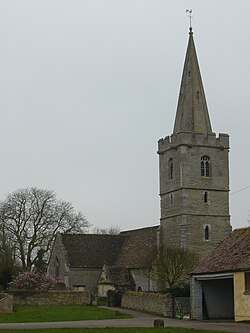Ashleworth
| Ashleworth | |
| Gloucestershire | |
|---|---|
 The Preaching Cross at Ashleworth | |
| Location | |
| Grid reference: | SO815254 |
| Location: | 51°55’37"N, 2°16’9"W |
| Data | |
| Postcode: | GL19 |
| Local Government | |
| Council: | Tewkesbury |
Ashleworth is a village in Gloucestershire, above the west bank of the River Severn, about six miles north of Gloucester. It has a riverside pub, the Boat Inn. The oldest part of the village is Ashleworth Quay, on the riverbank.
The population was recorded as 540 at the 2011 census.
History
The origins of the settlement go back at least to the Roman occupation; in recent years a number of Romano-British artefacts have been excavated in the area around the Quay dating from A.D.69 to A.D.390.
The village is mentioned in the Domesday Book of 1086, listed as Escelesworde, which renders the Old English Æscles weorþ, meaning 'Aescel's farmstead, or enclosure'.
After the Norman Conquest the manor was held by the Earls of Berkeley, but in the 12th century Robert Fitzharding, the earl at that time, gifted Ashleworth to St Augustine's Abbey, Bristol.
An ancient ferry, which used to link Ashleworth Quay to Sandhurst village on the east bank of the river closed in the 1950s. In the Middle Ages the Quay was a major crossing point for the river as the flood meadows here are narrower than they are for many miles upstream. Consequently, Ashleworth would have been the last place from which to cross before reaching the outskirts of Tewkesbury, nearly eight miles upstream.
After the Dissolution of the Monasteries, King Henry VIII gave the manor to the Bishop of Gloucester.
Parish church


The parish church is dedicated to Saints Andrew and Bartholomew. The church is primarily 12th and 13th century, with later remodelling, but the origins are pure Saxon. Much of the north wall is built of striking Saxon herringbone stonework.
The interior features one of the earliest known examples of a royal coat of arms mounted in a church, a practice which became commonplace in later centuries: the arms are those of the Tudor Kings of England, supported a lion and a dragon, erected over the south chapel, and dates from the reign of Edward VI or, possibly, Elizabeth I.
The church is Grade I listed.
Tythe Barn

- Main article: Ashleworth Tithe Barn
Ashleworth Tithe Barn adjacent to the court and church is a huge mediæval tithe barn, now in the care of the National Trust. The barn was built in the period 1481 - 1515 by Abbot Newland of Bristol Abbey. It consists of ten bays. The interior roofing is a wonderful example of mediæval timber framing.
About the village
Near the Quay is the ancient parish church of Saints Andrew and Bartholomew, the Manor, the Court, the historic Tithe Barn and the Boat Inn which has been run by the Jelf family for nearly 400 years.
The larger, more modern, part of the village spreads out from the attractive village green situated on higher ground about half a mile to the Northwest. Near the Green is the village school and the former Queens Arms public house, now a private residence, with the centre of the village with its Memorial Hall and Post Office shop being a couple of hundred yards further up the hill.
A 14th century preaching cross, simply known as 'The Preaching Cross' stands upon a three-step plinth on the village green. It is a simple column with a four-sided top which has been carved with religious scenes. The cross was lost for many years until it was found hidden in a chimney in one of the cottages that line the green. The scenes carved upon the cross are thought to represent Mary and John, a Virgin and Child, St Augustine, and Robert Fitzharding, founder of Bristol Abbey.
Ashleworth Court was built in 1460, and still retains its great hall. It is a Grade I listed building.
Ashleworth Manor (1460), a half-timbered manor house once was owned by the Abbot of Bristol.
Foscombe House, a Victorian Gothic fantasy, was built by Thomas Fulljames.
Outside links
| ("Wikimedia Commons" has material about Ashleworth) |